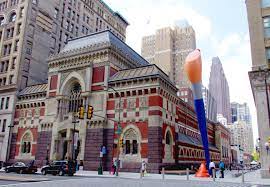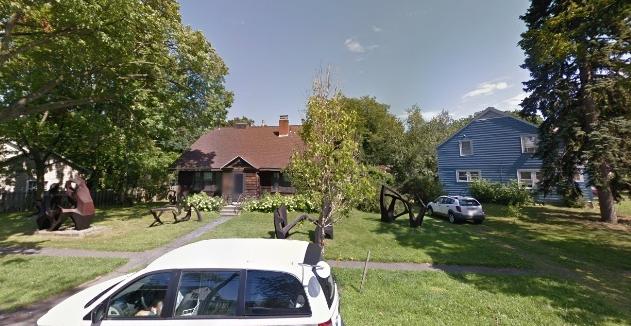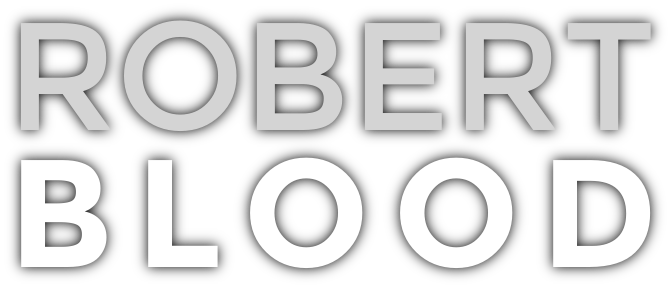ABOUT THE ARTIST
ROBERT BLOOD, AMERICAN SCULPTOR
1924-2016
“I’m attracted to asymmetry. Life is not predictable.”—Robert Blood
Robert Blood - A Life in Sculpture
A prolific artist with an intense energy, Robert Blood’s career as a sculptor spanned more than 60 years. Blood created a diverse body of work encompassing both figurative and abstract art forms. He produced unique cast figurative works, striking indoor welded sculptures made from Mild steel, and soaring outdoor sculptures made from welded weathering “Corten” (also Cor-Ten) steel.
Born in Schenectady, NY in 1924, Blood knew he wanted to be a sculptor at age 5 when he was given a lump of clay. After graduating from high school in 1942, he served in the US Army, stationed in Brooklyn.  After the war, Blood moved to Philadelphia to attend the Pennsylvania Academy of the Fine Arts (left) on the GI Bill. He learned under the guidance of his teachers Harry Rosin and Walker Hancock. There he had his first experience working with live models and developed a love of the female form, but he would later regret that the institution offered little exposure to abstract art. He moved to New York City in 1952 where he worked as a jeweler’s assistant for a short time before making jewelry on his own. While living in NYC he met a young artist named Esta Damesek. How the couple met is an amusing story. He married Esta in 1953 and they lived on Manhattan’s Lower East Side for a few years together designing unique jewelry that combined wood and metal; the pieces are still sought by collectors.
After the war, Blood moved to Philadelphia to attend the Pennsylvania Academy of the Fine Arts (left) on the GI Bill. He learned under the guidance of his teachers Harry Rosin and Walker Hancock. There he had his first experience working with live models and developed a love of the female form, but he would later regret that the institution offered little exposure to abstract art. He moved to New York City in 1952 where he worked as a jeweler’s assistant for a short time before making jewelry on his own. While living in NYC he met a young artist named Esta Damesek. How the couple met is an amusing story. He married Esta in 1953 and they lived on Manhattan’s Lower East Side for a few years together designing unique jewelry that combined wood and metal; the pieces are still sought by collectors.
 In 1955, the couple moved to Schenectady, NY, Blood’s hometown. While living there, Blood shifted his focus to sculpture and learned to weld. The couple’s only child, Peter, was born in 1960. In 1961, Blood became Artist-in-Residence at the old Schenectady Museum (right) which was then located on Steuben St. He was given use of the museum’s upstairs studio and apartment in exchange for a small stipend and teaching art and sculpture to the community. Blood lived, sculpted, and taught sculpture at the Schenectady Museum for the next 7 years. Blood thought the merits of the relationship were “not in its structure but in its flexibility.” Many of his students credit Blood with inspiring them to become artists themselves. Blood’s son Peter recalls a particularly memorable class. He began receiving commissions for both abstract and figurative sculpture. Living in the old museum gave rise to real “Night at the Museum” stories. The Schenectady Museum moved to a new building in 1968 and was renamed the Museum of Innovation and Science (miSci) in 2012.
In 1955, the couple moved to Schenectady, NY, Blood’s hometown. While living there, Blood shifted his focus to sculpture and learned to weld. The couple’s only child, Peter, was born in 1960. In 1961, Blood became Artist-in-Residence at the old Schenectady Museum (right) which was then located on Steuben St. He was given use of the museum’s upstairs studio and apartment in exchange for a small stipend and teaching art and sculpture to the community. Blood lived, sculpted, and taught sculpture at the Schenectady Museum for the next 7 years. Blood thought the merits of the relationship were “not in its structure but in its flexibility.” Many of his students credit Blood with inspiring them to become artists themselves. Blood’s son Peter recalls a particularly memorable class. He began receiving commissions for both abstract and figurative sculpture. Living in the old museum gave rise to real “Night at the Museum” stories. The Schenectady Museum moved to a new building in 1968 and was renamed the Museum of Innovation and Science (miSci) in 2012.
 In 1968, when the Schenectady Museum relocated, Blood moved his family into his childhood home, a small house on Regent Street (left) in the suburb of Niskayuna. Laboring many hours every day, the majority of hundreds of sculptures Blood created over his lifetime were created here. Blood lived a simple lifestyle and sometimes paid for services by bartering with his sculpture. Robert Blood died in 2016 at age 92, working right up until his death.
In 1968, when the Schenectady Museum relocated, Blood moved his family into his childhood home, a small house on Regent Street (left) in the suburb of Niskayuna. Laboring many hours every day, the majority of hundreds of sculptures Blood created over his lifetime were created here. Blood lived a simple lifestyle and sometimes paid for services by bartering with his sculpture. Robert Blood died in 2016 at age 92, working right up until his death.
Blood’s Artistic Philosophies:
“Bob Blood should feel comfortable taking his place among a select group of accomplished American sculptors.” His work “commands attention” and possesses the characteristic fundamentals of abstract art: “balance, silhouette, contour and shape. Blood’s creative energy is anchored in identifying, addressing and resolving these fundamentals.” —Michael Richman, Chesterwood Curator, 1980-1985, Stockbridge, MA.
Blood was fascinated by the human form and created figurative sculptures and figuratively-influenced abstract work simultaneously. He thought keeping his figurative skills sharp allowed him to not only better figurative sculpture, but better abstract sculpture. Blood’s abstract sculptures use Mild or Cor-Ten steel in a full-volumed way, with a generally curving sense of lightness to the lines. Shapes wrap around each other in space. They change aspect with every small move of the head, and by walking all around a piece one gets an endless span of spatial variation.
For over six decades, Robert Blood’s work has captivated admirers, won awards, and drew critical acclaim. Among the characteristics of Blood’s artwork are the following:
- Organic quality: Robert Blood’s abstract work has an organic quality, which reflects his lifelong love of both the human form and organic forms in nature. These organic elements are present in all of his abstract artwork but are most evident in The Bursting Seed and his Emerging Chrysalis series. Capital District art critic Peg Churchill Wright notes, “Blood’s sculptures have evolved from his work with the female figure. The grace and the soft curves remain, but there is also an angularity which plays upon the fluidity unexpectedly.”
- Asymmetrical design: Blood disliked symmetry and purposefully designed his figurative and abstract artwork to avoid it. He once commented that if one made a giant cube, there would be no need to walk around it, and that he knows he has succeeded when he sees people walking around his sculpture to view it from all angles.
- Use of negative space: Robert Blood was keenly aware of negative space. That is, he was as interested in where the sculpture was not as much as in where it was. “I want my pieces to be space embracing, not space displacing” Blood has said. Calligraphic Bridge is one example of his use of negative space, but there are numerous others.
- Bold expression: Blood’s work was intentionally bold. Blood wanted his sculpture to be thought provoking, inspirational, to evoke excitement and curiosity, and to “turn people on” even at the risk of turning some off. Eva Gemmill of the First Unitarian Society of Albany, called his Two Shapes Related “unusually provocative.” Another bold work is Blood’s suspended Crown of Thorns, commissioned by Our Lady of Victory in Troy. Blood’s son Peter recalls another bold sculpture.
How Blood Created His Welded Artwork
“In his art Robert Blood is a universal man, creating with the same devotion either a menorah or a crucifix, a human figure or an abstraction of the concepts of which the human mind and soul is capable—cunningly contrived, exquisitely formed, yet transcending materials and tools and craftsmanship to emerge as a paean to both man and his spirit.” —Duane LaFleche, Albany Times Union
The process by which Robert Blood created any large artwork began by making many drawings. From an idea, Blood would make more than a dozen drawings, then choose three or four to make 4-inch “maquettes” (a small scale models). Upon seeing the finished maquettes, he would then choose one to make into a full-size welding. This narrowing-down process ensured the only best pieces were chosen for welding. “I like to make my mistakes on a small scale” Blood has jested.
The process of creating his welded sculpture began with making a wire armature about ½ inch in diameter. He then precisely cut irregular shapes from sheet metal, using mild steel for indoor welded works and weathering “Corten” steel for outdoor works, in a process Blood often said was much like a tailor making clothes. First, he cut a paper template that carefully matched the shape needed, then he glued it to the metal, cut it out using an electric sheet metal shears, and removed the paper.
Next the difficult shaping work began. The cut piece was bent into the right shape by brute force, but changes were made incrementally. The pieces of sculpture did not simply fall into place. It was an iterative process of making many incremental adjustments. To make each piece fit perfectly, they had to be pried, bent, twisted, ground down with a grinder, and pounded. After each adjustment, he would try a piece in place only to inevitably find it needed more bending and pounding to fit precisely. Creating abstract sculpture this way was physically very demanding.
Only when the piece fit precisely could he tack it (spot welded) into place using an oxy-acetylene torch. Then he ran a bead along the entire seam. Unlike many sculptors who grind off the welded bead, Blood retains the bead, calling it “my signature.” Although an expert welder, he was rather humble about his welding skills. For Blood, the technique of welding was a necessary means to achieve a desired end, but his son Peter recalls how his father’s welding skills led to a job offer from NASA to weld moon rockets.
Outdoor Corten (also “Cor-Ten”) sculptures had an additional step. They were allowed to weather. Corten steel is actually designed to rust, yet it remains structurally strong and is used in both home and bridge construction. Corten requires no maintenance.
How Blood Created His Cast Artwork
“I adore the female figure. My work on the female form is the yin to the yang of my abstract pieces. One side energizes ideas about the other.” —Robert Blood
Because Blood typically used the lost-wax process which requires one to break the mold, most every blood figurative sculpture is unique. In addition to figurative work, Blood also cast maquettes, small studies for possible full-size abstract weldings.
Most of Robert Blood’s cast works were figurative and all of the figurative works were sculpted from live models. Blood’s son Peter noted his father was never shy about asking women to model. Peter is personally familiar with Blood’s modeling and casting process having modeled for his father about a dozen times with two important women in his life. “He began by taking measurements of the model’s arms, legs, and torso, then created several accurately proportioned wire armature models of different scales for future use. Dad did not instruct his models how to pose. He let them find their own pose, although he might suggest moving a leg or arm to avoid overly symmetric poses, finding asymmetry more interesting. When Dad liked what he saw, he began. First he bent a wire armature into the same pose. He worked in both clay and wax but primarily the latter. He applied small plates of wax roughly one inch square to the armature to create a very rough human form, removing pieces of the armature as he progressed. Over these plates he applied hundreds of elongated pea sized pieces of wax, one small piece at a time, until the sculpture was complete. This typically required models to pose for several hours. He liked the challenge of capturing physically strenuous poses and so sometimes used dancers as models (ballet, modern, even Hindu). Tiring poses required the model be given periods of rest and so took a few hours more.”
When the wax figure was completed, a mold was created. Blood typically used the lost-wax process to create his cast sculptures which resulted in a single unique sculpture. He did the gating himself. He attached a wax funnel to his wax sculpture by several wax “gates” (solid tubes). He then covered the sculpture, gating and funnel with alternating layers of grit (sand with asbestos) and a glue-like liquid which hardened into a solid mold.
Blood took the completed molds to a foundry where the pieces were fired, the wax burned out, and molten bronze or stainless steel poured in (stainless casting was more costly).
Once cooled, the fully cast molds where taken back to his studio where the mold was broken to reveal the metal sculpture, but this process was not simple. Chipping away every bit of mold took hours. Once that was complete, there were still many hours of additional work for the artist. The metal gating had to be cut off, burs removed, and the entire figure polished. Finally, a wooden base was carefully fashioned, sanded, stained, and attached to the sculpture by threaded rod, brazed to the sculpture, but hidden from sight.
The entire process required many hours. His son Peter tells of a humorous story when he once tried to calculate how many hours it required in an effort to calculate his father’s average hourly wage.
